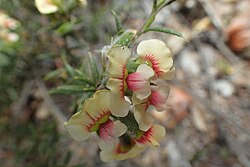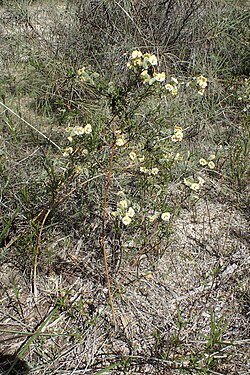Biology:Chorizema aciculare
| Chorizema aciculare | |
|---|---|

| |
| Subspecies laxum | |
| Scientific classification | |
| Kingdom: | Plantae |
| Clade: | Tracheophytes |
| Clade: | Angiosperms |
| Clade: | Eudicots |
| Clade: | Rosids |
| Order: | Fabales |
| Family: | Fabaceae |
| Subfamily: | Faboideae |
| Genus: | Chorizema |
| Species: | C. aciculare
|
| Binomial name | |
| Chorizema aciculare (DC.) C.A.Gardner[1]
| |
| Synonyms[1] | |
| |
Chorizema aciculare, commonly known as needle-leaved chorizema,[2] is a species of flowering plant in the family Fabaceae and is endemic to the southwest of Western Australia. It is a shrub with sharply-pointed leaves, the flower colour depending on subspecies.
Description
Chorizema aciculare is an erect or spreading shrub that typically grows to a height of 0.15–1.0 m (5.9 in–3 ft 3.4 in). The leaves are 8–28 mm (0.31–1.10 in) long with the edges rolled under, obscuring the lower surface in the case of subspecies aciculare. The flowers of subspecies aciculare are pink or orange, those of subsp. laxum usually pale yellow or orange.[2][3]
Taxonomy
Needle-leaved chorizema was first formally described in 1825 by Augustin Pyramus de Candolle who gave it the name Podolobium aciculare in Annales des Sciences Naturelles.[4][5] In 1930, Charles Gardner changed the name to Chorizema aciculare in his Enumeratio Plantarum Australiae Occidentalis.[6] The specific epithet (aciculare) means "needle-pointed", referring to the leaves.[7]
In 1992, Joan M. Taylor and Michael Crisp described two subspecies of C. aciculare in Australian Systematic Botany , and the names are accepted by the Australian Plant Census:
- Chorizema aciculare (DC.) C.A.Gardner subsp. aciculare;[8]
- Chorizema aciculare subsp. laxum J.M.Taylor & Crisp.[9]
Distribution and habitat
Chorizema aciculare mostly grows in woodland or coastal kwongan on granite outcrops, undulating plains, ridges or on coastal dunes and is widespread from near Geraldton to Israelite Bay in the south-west of Western Australia.[2][3]
References
- ↑ 1.0 1.1 "Chorizema aciculare". Australian Plant Census. https://biodiversity.org.au/nsl/services/apc-format/display/66793.
- ↑ 2.0 2.1 2.2 "Chorizema aciculare". FloraBase. Western Australian Government Department of Parks and Wildlife. https://florabase.dpaw.wa.gov.au/browse/profile/3751.
- ↑ 3.0 3.1 Corrick, Margaret G.; Fuhrer, Bruce (2009). Wildflowers of southern Western Australia (3rd ed.). Kenthurst, N.S.W.: Rosenberg Pub. p. 58. ISBN 9781877058844.
- ↑ "Podolobium aciculare". APNI. https://id.biodiversity.org.au/instance/apni/516588.
- ↑ de Candolle, Augustin P. (1825). "Notice sur quelques genres et speces nouvelles de legumineuses, extraite de divers Memoires presentes a la Societe d'Histoire naturelle de Geneve, pendant le cours des annees 1823 et 1824.". Annales des Sciences Naturelles 4: 98. https://www.biodiversitylibrary.org/item/47903#page/104/mode/1up. Retrieved 2 October 2022.
- ↑ "Chorizema aciculare". APNI. https://id.biodiversity.org.au/instance/apni/556921.
- ↑ Sharr, Francis Aubi; George, Alex (2019). Western Australian Plant Names and Their Meanings (3rd ed.). Kardinya, WA: Four Gables Press. p. 126. ISBN 9780958034180.
- ↑ "Chorizema aciculare subsp. aciculare". Australian Plant Census. https://biodiversity.org.au/nsl/services/apc-format/display/117874.
- ↑ "Chorizema aciculare subsp. laxum". Australian Plant Census. https://biodiversity.org.au/nsl/services/apc-format/display/117877.
Wikidata ☰ {{{from}}} entry


